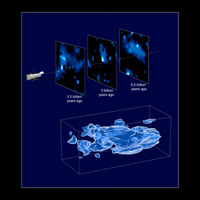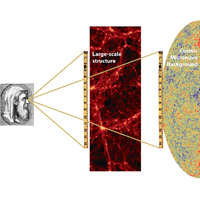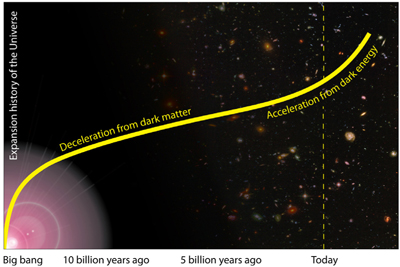Science Goals
 |
| Cosmic budget. Credit: ESA |
Until about thirty years ago astronomers thought that the Universe was composed almost entirely of ordinary matter: protons, neutrons, electrons and atoms. In the intervening years the emerging picture of the composition of the Universe has changed dramatically. It is now assumed that ordinary matter makes up only about 5% of the Universe, and that the mass-energy budget of the Universe is actually dominated by two mysterious components: dark energy and dark matter.
Dark energy, which accounts for the vast majority (69%) of the energy density of the Universe, is causing the expansion of the Universe to accelerate. The existence and energy scale of dark energy cannot be explained with our current knowledge of fundamental physics.
The remaining 26% of the energy density is in the form of dark matter, which, like ordinary matter, exerts a gravitational attraction, but unlike normal matter does not emit light. The nature of dark matter is unknown, although several candidates are predicted by supersymmetric extensions of the standard model of particle physics. Plausible candidates for the cold dark matter are the axion and the lightest supersymmetric particle; massive neutrinos can account for the hot dark matter. One possibility to explain one or both of these puzzling components is that Einstein's Theory of General Relativity, and thus our understanding of gravity, needs to be revised on cosmological scales. Together, dark energy and dark matter pose some of the most important questions in fundamental physics today.
Euclid's cosmological probes
Euclid will map the large-scale structure of the Universe over the entire extragalactic sky - or half of the full sky excluding the regions dominated by the stars in our Milky Way. It will measure galaxies out to redshifts of ~2, which corresponds to a look-back time of about 10 billion years, thus covering the period over which dark energy accelerated the expansion of the Universe.
Euclid is optimised for two primary cosmological probes:
- Weak gravitational Lensing (WL): Weak lensing is a method to map the dark matter and measure dark energy by measuring the distortions of galaxy images by mass inhomogeneities along the line-of-sight.
- Baryonic Acoustic Oscillations (BAO): BAOs are wiggle patterns, imprinted in the clustering of galaxies, which provide a standard ruler to measure dark energy and the expansion in the Universe.
Weak gravitational lensing requires extremely high image quality because possible image distortions by the optical system must be suppressed or calibrated-out to be able to measure the true distortions by gravity.
The Euclid baryonic acoustic oscillations experiment involves the determination of the redshifts of galaxies to better than 0.1%, this can only be accomplished through spectroscopy.
 |
 |
|
Illustration of the two primary cosmological probes of Euclid: weak gravitational lensing (left) and Baryonic Acoustic Oscillations (right). Credit: (right) NASA, ESA, and R. Massey. |
|
Surveyed in the same cosmic volume, these techniques not only provide systematic cross-checks but also a measurement of large scale structure via different physical fields (potential, density and velocity), which are required for testing dark energy and gravity on cosmological scales.
With its wide-field capability and high-precision design, Euclid will:
- Investigate the properties of the dark energy by accurately measuring both the acceleration as well as the variation of the acceleration at different ages of the Universe
- Test the validity of general relativity on cosmic scales
- Investigate the nature and properties of dark matter by mapping the 3-dimensional dark matter distribution in the Universe
- Refine the initial conditions at the beginning of our Universe, which seed the formation of the cosmic structures we see today.
Euclid is therefore poised to uncover new physics by challenging all sectors of the cosmological model. The Euclid survey can thus be thought of as the low-redshift, 3-dimensional analogue and complement to the map of the high-redshift Universe provided by ESA's Planck mission.
Additional science with Euclid
Euclid will produce a massive legacy of deep images and spectra over at least half of the entire sky. This will be a unique resource for the astronomical community and will impact upon all areas of astronomy. Euclid’s spatial resolution of 0.2 seconds of arc is only achievable from space, and is comparable to the Hubble Space Telescope. With Euclid, the majority of the new sources identified by future imaging observatories, from radio to X-rays, will be readily associated to a known redshift, out to a redshift z~2. This adds an enormous power to the science return of these other projects, as it eliminates the time-consuming phase of redshift follow-up. Euclid will be a discovery machine on an unprecedented scale, and may well be the major feeder for more detailed studies both with ground-based facilities and future satellites.




